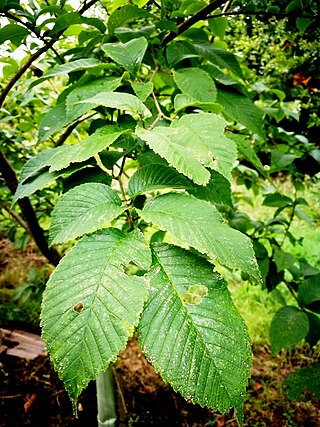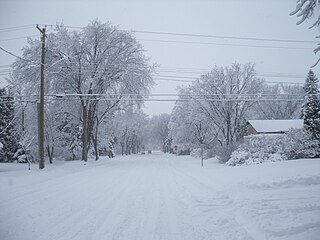
Ulmus changii, occasionally known as the Hangzhou elm, is a small deciduous tree found across much of China in forests at elevations of up to 1800 m. Owing to its increasing scarcity, U. changii was added to the Hainan Province Protected Plants List in 2006.
Ulmus glaucescensFranch., the Gansu elm, is a small deciduous tree from the northern provinces of China, where it is found along river valleys and on mountain slopes at elevations of 2000–2600 m.

Ulmus lamellosa, commonly called the Hebei elm, is a small deciduous tree native to four Chinese provinces, Hebei, Henan, Nei Mongol, and Shanxi, to the west and south of Beijing.

Ulmus prunifoliaW. C. Cheng & L. K. Fu, the cherry-leafed elm, is a deciduous tree endemic only to the province of Hubei in central eastern China, where it is found at elevations of 1000–1500 m.

Ulmus lanceifoliaRoxburgh, ex Wall., occasionally known as the Vietnam elm, is a very large tree endemic to a wide area of southern Asia. Its range extends southeast and eastwards from Darjeeling in the Himalaya, through Bangladesh, southern China, Myanmar, Thailand, Laos, Vietnam and on discontinuously into Indonesia, straddling the Equator in Sumatra and Celebes.

The American elm cultivar Ulmus americana 'Augustine', originally called 'Augustine Ascending', was cloned by Archie M. Augustine of the Augustine Nursery of Bloomington, Illinois, from a nursery seedling planted in 1927 in Normal, Illinois, and found to be columnar in habit.
The American Elm cultivar Ulmus americana 'Independence' was raised by Eugene B. Smalley and Donald T. Lester at the University of Wisconsin–Madison from a crossing of the American Elm cultivar Moline and American Elm clone W-185-21, to become one of the six clones forming the American Liberty series, and the only one to be patented.
The American Elm cultivar Ulmus americana 'Exhibition' is a selection made by the Patmore Nurseries from seeds of a tree at Brandon, Manitoba. Released in 1952, 'Exhibition' was propagated by grafting.
The American Elm cultivar Ulmus americana 'Patmore' was selected and raised by R. H. Patmore from a native tree in Brandon, Manitoba, Canada. It may be synonymous with another cultivar from the same source, known as 'Brandon'.
The American Elm cultivar Ulmus americana 'Littleford' was cloned from a tree in Hinsdale, Illinois, circa 1915 by Littleford Nurseries of Downers Grove, Illinois, and first released in 1927. It was marketed in the 1930s by nearby Hinsdale Nurseries, successor to Littleford Nurseries, as 'Littlefordii'. In their 1925 catalogue Littleford Nurseries had written of their selection: "The growing of the American elm is a specialty with us; we consider it the leading shade and ornamental tree. Our trees are a selected strain of the V-shaped type, a stock of 15 to 20 thousand, all 2 ins. and up in size, transplanted twice and in splendid vigor for planting".
The American elm cultivar Ulmus americana 'Ascendens', 'Upright American Elm', was cloned c.1910 by Bernard H. Slavin, Superintendent of Parks, Rochester, New York, from a tree growing in Seneca Park, Rochester, and named in 1927 for its narrow oval form.

The American elm cultivar Ulmus americana 'Aurea' was cloned from a tree discovered by F. L. Temple in Vermont at the end of the 19th century.

The American elm cultivar Ulmus americana 'Beaverlodge' was selected as a seedling in 1925 at the Beaverlodge Experimental Farm, Morden, Manitoba, part of the Lacombe Research Centre, Alberta, for its hardiness and vigour, and released in 1954.

The American Elm cultivar Ulmus americana 'Columnaris' was propagated by R. E. Horsey of the Rochester N.Y. Parks Department from a tree found by Mr John Dunbar at Conesus Lake, New York, in 1911, and originally described as a forma, Ulmus americana L. f. columnaris, f. nov.Rehder (1922). It was the earliest of a number of compact, columnar American elm cultivars, to be followed by 'Ascendens' and 'Augustine Ascendening'.
The American Elm cultivar Ulmus americana 'Fiorei' was raised by the Charles Fiore Nurseries, Prairie View, Illinois, before 1949, and first listed as 'Fiorii', Fiore Elm, without description. It is no longer listed by the company.
The American Elm cultivar Ulmus americana 'Kimley' was cloned c.1957 by the Sheridan Nurseries, Mississauga, Canada, from a large tree found near Oshawa, Ontario, Canada.
The American Elm cultivar Ulmus americana 'Morden' was cloned from a selection made by the Dominion Experimental Farm, Morden, Manitoba, in 1939 on account of its ability to withstand severe ice storms without breakage.
The American Elm cultivar Ulmus americana 'Iowa State' was cloned in the 1980s from a tree discovered by Professor Alexander (Sandy) McNabb of Iowa State University as the sole survivor in 40 acres (16 ha) of diseased elm at Burlington.
The American Elm cultivar Ulmus americana 'L'Assomption' was selected from seedlings grown from X-irradiated seed at the eponymous experimental station in Quebec before 1965.
The American Elm cultivar Ulmus americana 'Jackson' was cloned c.1990 from an elm selected at Wichita, Kansas, which had reputedly shewn no signs of Dutch elm disease damage at over 50 years of age.







